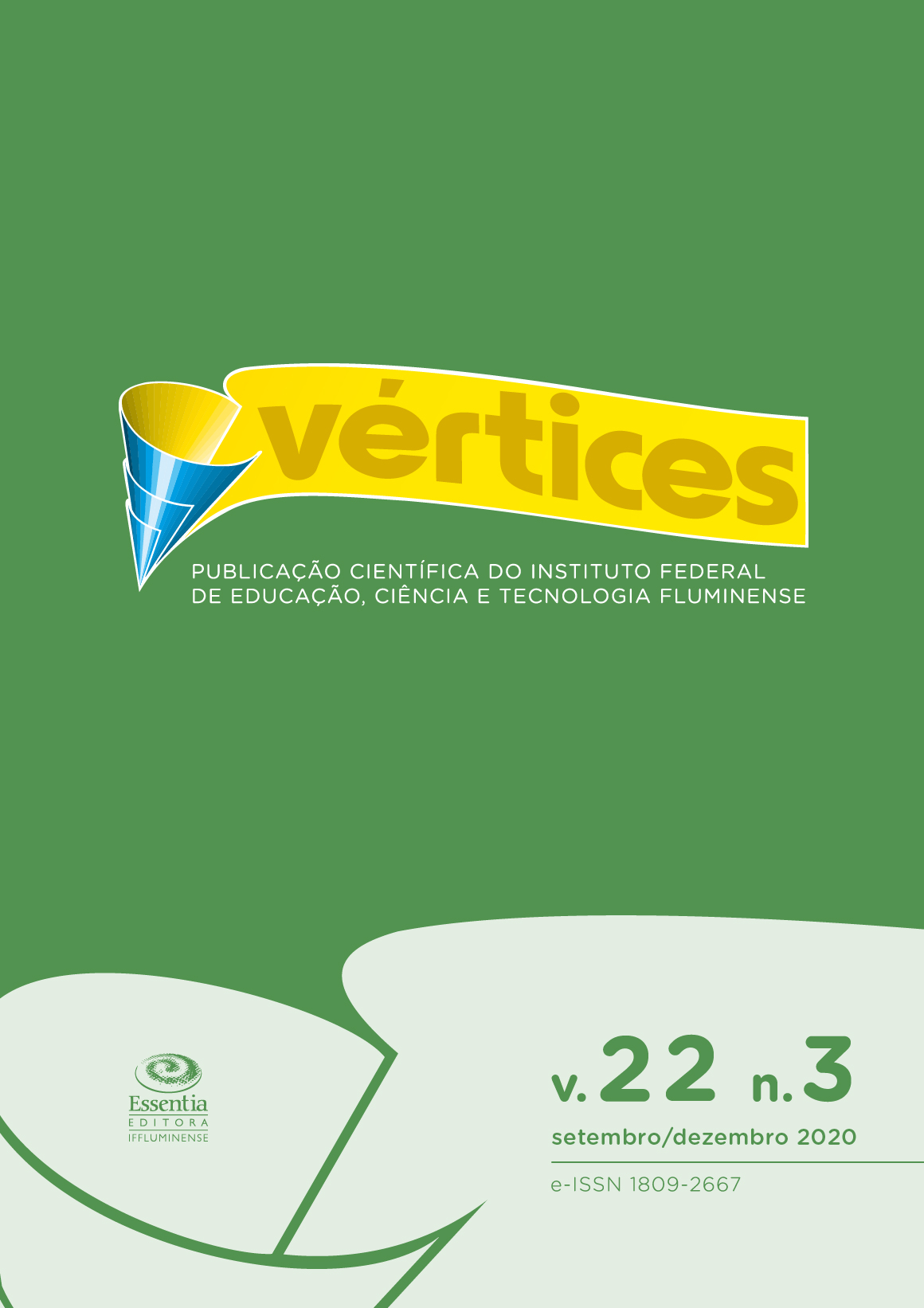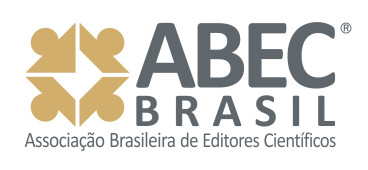Prevalência de mosaicismo cromossômico em 2.500 casos realizados em um laboratório de genética no Estado do Rio de Janeiro, Brasil
DOI:
https://doi.org/10.19180/1809-2667.v22n32020p579-589Palavras-chave:
Citogenética, Alterações Cromossômicas, Mosaicismo Cromossômico, GenéticaResumo
Mosaicismo cromossômico é definido como a existência de duas ou mais linhagens celulares com diferentes constituições cromossômicas em um mesmo indivíduo. Este trabalho tem como objetivo analisar a prevalência de mosaicismo cromossômico a partir de 2.500 pacientes que realizaram estudo citogenético em um laboratório de genética localizado em um município do Estado do Rio de Janeiro, RJ, no período de 04/2011 a 01/2020. Dos 2.500 exames de cariótipo analisados, 19 apresentaram mosaicismo cromossômico, sendo nove do sexo feminino, oito do sexo masculino e dois casos de sexo indefinidos. Em relação ao tipo da alteração cromossômica, 14 casos foram de alterações numéricas e cinco casos de alterações estruturais. Infertilidade foi a indicação clínica mais prevalente, totalizando sete pacientes. Dentre os 19 casos neste estudo, dois foram publicados em revistas científicas. O mosaicismo cromossômico pode apresentar linhagens de células com porcentagens muito variadas. Para uma maior segurança, sugere-se a contagem de um número maior de células para aumentar a chance de identificação destas alterações.Downloads
Referências
AL-ACHKAR, W. et al. Detailed analysis of an idic(Y)(q11.21) in a mosaic karyotype. Mol Med Rep, Athens, v. 6, p. 293-296, 2012. Disponível em: https://www.spandidos-publications.com/10.3892/mmr.2012.930. Acesso em: 10 jan. 2020.
ALLANSON, J. E.; GRAHAM, G. E. Principles and Practice of Medical Genetics. 4th. ed. Churchill Livingstone, Edinburgh: Academic Press, 2002.
ALTER, B. P. et al. Fanconi anemia: myelodysplasia as a predictor of outcome. Cancer Genet Cytogenet, New York, v. 17, p. 125–131, 2000. DOI: https://doi.org/10.1016/s0165-4608(99)00159-4. Disponível em: https://www.sciencedirect.com/science/article/abs/pii/S0165460899001594. Acesso em: 9 jan. 2020.
BALKAN, M. et al. Cytogenetic analysis of 4216 patients referred for suspected chromosomal abnormalities in Southeast Turkey. Genet Mol Res, Ribeirão Preto, v, 9, n. 2, p. 1094-103, 2010. DOI: https://doi.org/10.4238/vol9-2gmr827. Disponível em: http://citeseerx.ist.psu.edu/viewdoc/download?doi=10.1.1.603.9118&rep=rep1&type=pdf. Acesso em: 20 jan. 2020.
BIESECKER, L. G.; SPINNER, N. B. A genomic view of mosaicism and human disease. Nat Rev Genet, London, v. 14, n. 5, p. 307–20, 2013. DOI: https://doi.org/10.1038/nrg3424. Disponível em: https://www.nature.com/articles/nrg3424. Acesso em: 10 fev. 2020.
BONTHRON, D. T.; STRAIN L.; DEAN J. C. S. Amalgamation of in vitro fertilized embryos, resulting in birth of a true hermaphrodite chimera. Am J Hum Genet, Hampshire, v. 61, p. A147, 1997. Disponível em: https://scirp.org/reference/referencespapers.aspx?referenceid=362514. Acesso em: 4 jan. 2020.
BORNSTEIN, E. et al. Comparison of modes of ascertainment for mosaic vs complete trisomy 21. Am J Obstet Gynecol, New York, v. 200, p. 440.e1–e5, 2009. DOI: https://doi.org/10.1016/j.ajog.2009.01.017. Disponível em: https://www.sciencedirect.com/science/article/abs/pii/S0002937809000994. Acesso em: 3 jan. 2020.
CONLIN, L. K. et al. Mechanisms of mosaicism, chimerism and uniparental disomy identified bysingle nucleotide polymorphism array analysis. Hum. Mol. Genet, New York, v. 19, p. 1263–1275, 2010. DOI: https://doi.org/10.1093/hmg/ddq003. Disponível em: https://academic.oup.com/hmg/article/19/7/1263/2901116. Acesso em: 4 jan. 2020.
DE LA CHAPELLE, A. The etiology of maleness in XX men. Hum Genet, Berlin, v. 58, n. 1, p. 105-16, 1981. DOI: 10.1007/BF00284157. Disponível em: https://link.springer.com/content/pdf/10.1007/BF00284157.pdf. Acesso em: 5 dez. 2019.
DUARTE, A. C. et al. Cytogenetics of genetic counseling patients in Pelotas, Rio Grande do Sul, Brazil. Genet Mol Res, Ribeirão Preto, v. 3, n. 3, p. 303-308, 2008. Disponível em: http://citeseerx.ist.psu.edu/viewdoc/download?doi=10.1.1.498.7712&rep=rep1&type=pdf. Acesso em: 25 jan. 2020.
FAGERBERG, C. R. et al. Trisomy 14 mosaicism: clinical and cytogenetic findings in an adult. Clinical dysmorphology, London, v. 21, n. 1, p. 45-47, 2012. DOI: https://doi.org/10.1097/MCD.0b013e32834a0436. Disponível em: https://journals.lww.com/clindysmorphol/Fulltext/2012/01000/Trisomy_14_mosaicism_clinical_and_cytogenetic.12.aspx. Acesso em: 22 jan. 2020.
FEUK, L.; CARSON, A. R.; SCHERER, S. W. Structural variation in the human genome. Nature Rev Genet, London, v. 7, p. 85-97, 2006. Disponível em: https://www.nature.com/articles/nrg1767. Acesso em: 2 abr. 2020.
FUJIMOTO, A. et al. Natural history of mosaic trisomy 14 syndrome. American journal of medical genetics, New York, v. 44, n. 2, p. 189-196, 1992. DOI: https://doi.org/10.1002/ajmg.1320440214. Disponível em: https://onlinelibrary.wiley.com/doi/abs/10.1002/ajmg.1320440214. Acesso em: 3 fev. 2020.
GARDNER, R. J. M; SUTHERLAND, G.R.; SHAFFER, L. G. Chromosome abnormalities and genetic counseling. 4th. ed. Oxford University Press: Oxford, 2012.
GERSAK, K.; VEBLE, A. Low-level X chromosome mosaicism in women with sporadic premature ovarian failure. Reproductive biomedicine online, Amsterdam, v. 22, n. 4, p. 399-403, 2011. DOI: https://doi.org/10.1016/j.rbmo.2011.01.002. Disponível em: https://www.sciencedirect.com/science/article/pii/S1472648311000125. Acesso em: 5 fev. 2020.
GERSEN, S. L.; KEAGLE, M. B. The principles of clinical cytogenetics. 2nd. ed. New Jersey: Humana Press, 2004.
GOSWAMI, D.; CONWAY, G. S. Premature ovarian failure. Hum. Reprod, Oxford, v. 11, p. 391–410, 2005. DOI: https://doi.org/10.1093/humupd/dmi012. Disponível em: https://academic.oup.com/humupd/article-abstract/11/4/391/874983. Acesso em: 18 fev. 2020.
HASSOLD, T.; HUNT, P. To err (meiotically) is human: the genesis of human aneuploidy. Nat Rev Genet, London, v. 2, p. 280-291, 2001. Disponível em: https://www.nature.com/articles/35066065. Acesso em: 4 fev. 2020.
HOULIHAN O. A., O’DONOGHUE K. The natural history of pregnancies with a diagnosis of trisomy 18 or trisomy 13; a retrospective case series. BMC Pregnancy Childbirth, London, v. 13, p. 209, 2013. DOI: https://doi.org/10.1186/1471-2393-13-209. Disponível em: https://link.springer.com/article/10.1186/1471-2393-13-209. Acesso em: 4 fev. 2020.
ISCN. International Standing Committee on Human Cytogenomic Nomenclature. ISCN: an international system for human cytogenomic nomenclature (2016). Karger: New York, 2016.
JACKSON-COOK, C. Constitutional and acquired autosomal aneuploidy. Clin Lab Med, Philadelphia, v. 31, p. 481–511, 2011. DOI: https://doi.org/10.1016/j.cll.2011.08.002. Disponível em: https://www.labmed.theclinics.com/article/S0272-2712(11)00068-0/abstract. Acesso em: 1 jan. 2020.
JUNG, M. P. et al. Diagnóstico da Síndrome de Turner: a experiência do Instituto Estadual de Diabetes e Endocrinologia - Rio de Janeiro, de 1970 a 2008. Revista Brasileira de Saúde Materno Infantil, Recife, v. 10, n. 1, p. 117-124, 2010. DOI: https://doi.org/10.1590/S1519-38292010000100012. Disponível em: https://www.scielo.br/scielo.php?script=sci_arttext&pid=S1519-38292010000100012&lang=pt. Acesso em 21 fev. 2020.
KIM, J.W. et al. SRY-negative 46,XX infertile male with Leydig cell hyperplasia: clinical, cytogenetic, and molecular analysis and review of the literature. Fertil Steril, New York, v. 94, n. 2: p. 753.e5-9, 2010. DOI: https://doi.org/10.1016/j.fertnstert.2010.01.050. Disponível em: https://www.sciencedirect.com/science/article/pii/S0015028210001251. Acesso em: 1 jan. 2020.
LAKHAL, B. et al. Cytogenetic analyses of premature ovarian failure using karyotyping and interphase fluorescence in situ hybridization (FISH) in a group of 1000 patients. Clin. Genet, Copenhagen, v. 78, p. 181–185, 2010. DOI: https://doi.org/10.1111/j.1399-0004.2009.01359.x. Disponível em: https://onlinelibrary.wiley.com/doi/abs/10.1111/j.1399-0004.2009.01359.x. Acesso em: 19 fev. 2020.
LY, D.H. et al. Mitotic misregulation and human aging. Science, New York, v. 287, p. 2486–2492, 2000. DOI: https://doi.org/10.1126/science.287.5462.2486. Disponível em: https://science.sciencemag.org/content/287/5462/2486.abstract. Acesso em: 3 fev. 2020.
MAU, U.A. et al. Chromosomal findings in 150 couples referred for genetic couselling prior to intracytoplasmic sperm injection. Hum Reprod, Oxford, v. 12, p. 930–937, 1997. DOI: https://doi.org/10.1093/humrep/12.5.930. Disponível em: https://academic.oup.com/humrep/article-abstract/12/5/930/665457. Acesso em: 3 fev. 2020.
MESCHEDE, D. et al. Chromosome abnormalities in 447 couples undergoing intracytoplasmic sperm injection prevalence, types, sex distribution and reproductive relevance. Hum Reprod, Oxford, v. 13, p. 576–582, 1998. DOI: https://doi.org/10.1093/humrep/13.3.576. Disponível em: https://academic.oup.com/humrep/article-abstract/13/3/576/733528. Acesso em: 3 fev. 2020.
PAPAVASSILIOU, P. et al. The phenotype of persons having mosaicism for trisomy 21/Down syndrome reflects the percentage of trisomic cells present in different tissues. Am J Med Genet Part A, Hoboken, v. 149A, p. 573-583, 2009. DOI: https://doi.org/10.1002/ajmg.a.32729. Disponível em: https://onlinelibrary.wiley.com/doi/abs/10.1002/ajmg.a.32729. Acesso em: 2 fev. 2020.
RODRIGUES, M. A. et al. Low-level trisomy 14 mosaicism in a male newborn with ectrodactyly. Genet Mol Res, v. 15, p. 1-7, 2016.
RODRIGUES, M. A. et al. Mosaic 15q duplication syndrome (tetrasomy 15q11. 1-q13. 2) in a child with behavior disorders: case report. Brazilian Journal of Psychiatry, v. 41, n. 1, p. 93-95, 2019.
RUSSELL, L.M. et al. X chromosome loss and ageing. Cytogenet. Genome. Res, Basel, v. 116, p. 181–185, 2007. DOI: https://doi.org/10.1159/000098184. Disponível em: https://www.karger.com/Article/Abstract/98184. Acesso em: 3 fev. 2020.
SHARP, A.J.; CHENG, Z.; EICHLER, E.E. Structural variation of the human genome. Annu Rev Genomics Hum Genet, London, v. 7, p. 407–442, 2006. Disponível em: https://www.nature.com/articles/nrg1767. Acesso em: 3 fev. 2020.
SHIN, M.; SIFFEL, C.; CORREA, A. Survival of children with mosaic Down syndrome. Am J Med Genet Part A, Hoboken, v. 152A, p. 800–801, 2010. DOI: https://doi.org/10.1002/ajmg.a.33295. Disponível em: https://www.academia.edu/download/47586268/ajmg.a.3329520160728-27005-w4ubto.pdf. Acesso em: 3 fev. 2020.
SIMPSON, J. L. Genetic and phenotypic heterogeneity in ovarian failure: overview of selected candidate genes. Ann. N. Y. Acad. Sci, New York, v. 11, p. 146–154, 2008. DOI: https://doi.org/10.1196/annals.1429.019. Disponível em: https://nyaspubs.onlinelibrary.wiley.com/doi/abs/10.1196/annals.1429.019. Acesso em: 3 fev. 2020.
SONNTAG, B. et al. Low-level sex chromosome mosaicism in female partners of couples undergoing ICSI therapy does not significantly affect treatment outcome. Hum Reprod, Oxford, v. 16, p. 1648–1652, 2001. DOI: https://doi.org/10.1093/humrep/16.8.1648. Disponível em: https://academic.oup.com/humrep/article-abstract/16/8/1648/624671. Acesso em: 3 fev. 2020.
SOYLEMEZ, F. Double Aneuploidy in Down Syndrome, Health Problems in Down Syndrome. London: IntechOpen, 2015. E-book. Disponível em: https://www.intechopen.com/books/health-problems-in-down-syndrome/double-aneuploidy-in-down-syndrome. Acesso em: 10 dez. 2019.
UEHARA, S. et al. Molecular biologic analyses of tetragametic chimerism in a true hermaphrodite with 46,XX/46,XY. Fertil Steril, New York, v. 63, p. 189–192, 1995. DOI: https://doi.org/10.1016/s0015-0282(16)57317-8. Disponível em: https://pubmed.ncbi.nlm.nih.gov/7805911/. Acesso em: 20 fev. 2020.
VAN DOOREN, M.F.; BERTOLI-AVELLAB, A.M.; OLDENBURG, R.A. Premature ovarian failure and gene polymorphisms. Curr. Opin. Obstet. Gynecol, Philadelphia, v. 21, p. 313–317, 2009. DOI: https://doi.org/10.1097/GCO.0b013e32832e0813. Disponível em: https://cdn.journals.lww.com/co-obgyn/Fulltext/2009/08000/Premature_ovarian_failure_and_gene_polymorphisms.5.aspx. Acesso em: 3 fev. 2020.
WISE, J. L. et al. Cryptic subtelomeric rearrangements and X chromosome mosaicism: a study of 565 apparently normal individuals with fluorescent in situ hybridization. PLoS. One, San Francisco, v. 10, e5855, 2009. DOI: https://doi.org/10.1371/journal.pone.0005855. Disponível em: https://journals.plos.org/plosone/article?id=10.1371/journal.pone.0005855. Acesso em: 3 fev. 2020.
WONG, M.S.; LAM, S.T. Cytogenetic analysis of patients with primary and secondary amenorrhoea in Hong Kong: retrospective study. Hong Kong Med, Hong Kong, J. v. 11, p. 267–672, 2005. Disponível em: http://citeseerx.ist.psu.edu/viewdoc/download?doi=10.1.1.507.4647&rep=rep1&type=pdf. Acesso em: 3 fev. 2020.
YU, N. et al. Disputed maternity leading to identification of tetragametic chimerism. N Engl J Med, Boston, v. 346, p. 1545–1552, 2002. DOI: https://doi.org/10.1056/NEJMoa013452. Disponível em: https://www.nejm.org/doi/full/10.1056/nejmoa013452. Acesso em: 3 fev. 2020.
ZARAGOZA, M. et al. Nondisjunction of human acrocentric chromosomes: studies of 432 fetuses and liveborns. Hum. Genet, Berlin, v. 94, p. 411–417, 1994. DOI: https://doi.org/10.1007/BF00201603. Disponível em: https://link.springer.com/content/pdf/10.1007/BF00201603.pdf. Acesso em: 3 fev. 2020.
Publicado
Edição
Seção
Licença
Copyright (c) 2020 Mauricio Assis Rodrigues, Bianca Rodrigues Marques Peterle, Erick de Souza Costa, Antonio Francisco Alves da Silva, Patricia Damasceno Ribeiro

Este trabalho está licenciado sob uma licença Creative Commons Attribution 4.0 International License.
Os autores do manuscrito submetido à revista Vértices, representados aqui pelo autor correspondente, concordam com os seguintes termos:
Os autores mantêm os direitos autorais e concedem sem ônus financeiro à revista Vértices o direito de primeira publicação.
Simultaneamente o trabalho está licenciado sob a Licença Creative Commons Atribuição 4.0 Internacional (CC BY 4.0), que permite copiar e redistribuir os trabalhos por qualquer meio ou formato, e também para, tendo como base o seu conteúdo, reutilizar, transformar ou criar, com propósitos legais, até comerciais, desde que citada a fonte.
Os autores não receberão nenhuma retribuição material pelo manuscrito e a Essentia Editora irá disponibilizá-lo on-line no modo Open Access, mediante sistema próprio ou de outros bancos de dados.
Os autores têm autorização para assumir contratos adicionais separadamente, para distribuição não exclusiva da versão do trabalho publicada na revista Vértices (ex.: publicar em repositório institucional ou como capítulo de livro), com reconhecimento de autoria e publicação inicial neste periódico.
Os autores têm permissão e são estimulados a divulgar e distribuir seu trabalho online na versão final (posprint) publicada pela revista Vértices em diferentes fontes de informação (ex.: em repositórios institucionais ou na sua página pessoal) a qualquer tempo posterior à primeira publicação do artigo.
A Essentia Editora poderá efetuar, nos originais, alterações de ordem normativa, ortográfica e gramatical, com o intuito de manter o padrão culto da língua, contando com a anuência final dos autores.
As opiniões emitidas no manuscrito são de exclusiva responsabilidade do(s) autor(es).























1.png)



